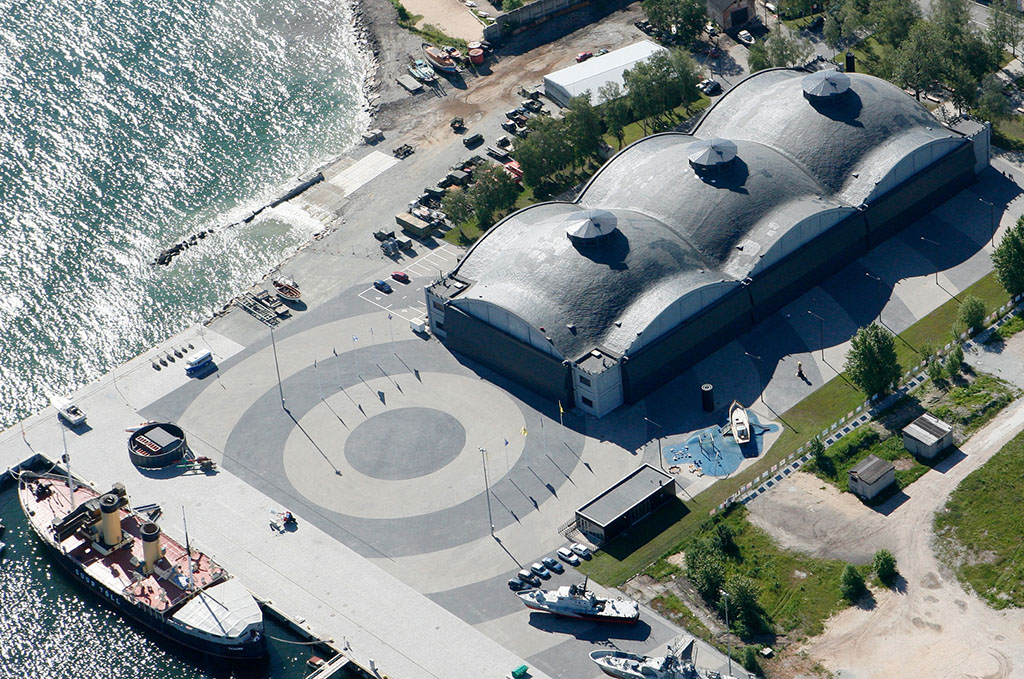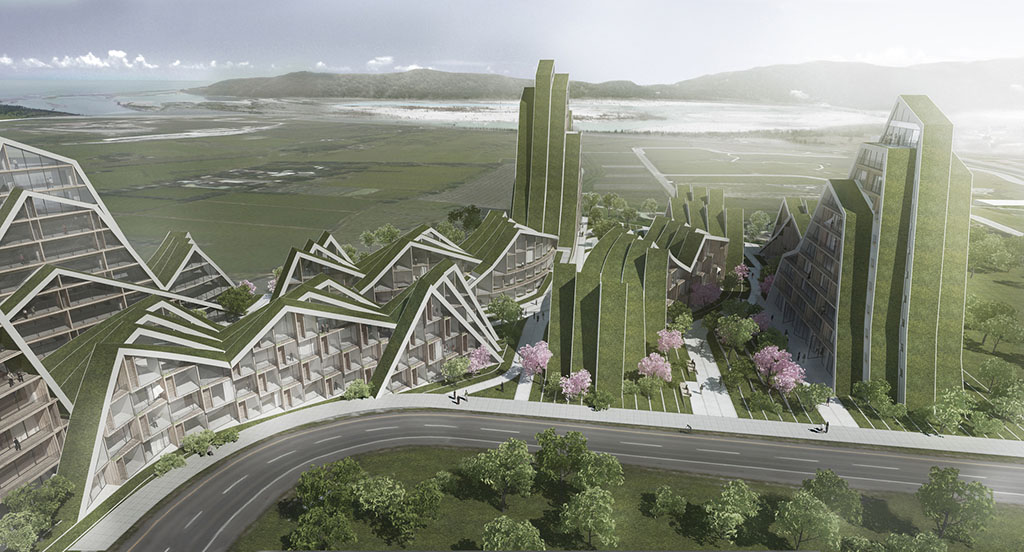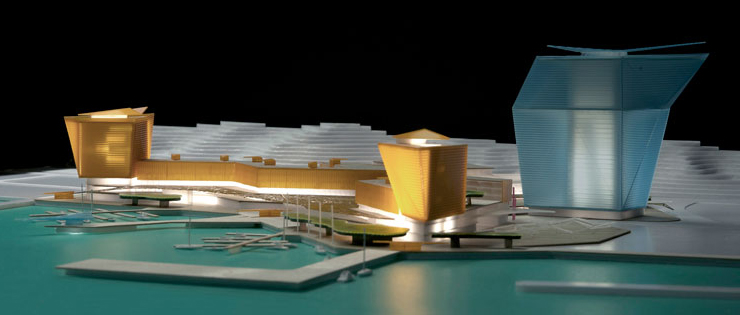Real estate and urban redevelopment at the EIRE in Milan
Relaunching the real estate sector in this particular moment of economic crisis means to encourage public and private investment, promoting innovation of contents and processes that underlie of the real estate projects, with a particular attention to the urban quality and environmental sustainability. This is what emerged in the tenth edition of EIRE (Expo Italia Real Estate) which was held in Milan from 24 to 25 June 2014 and in some recent projects successful, highly innovative, which testify the dynamism and the entrepreneurial resources in contexts where the innovation and free competition are interpreted as positive factors.
Among the issues at the heart of the most recent proposals, they are certainly worth noting the social housing, the expansion of the rental market, the requalification of existing assets and abandoned, the sustainable construction and the energy saving.
Tallinn Seaplane Harbour, Tallinn, Estonia
More…
It is important to emphasize that the logics of social and environmental development, which are strongly linked to the economic and cultural regeneration, produce often new scenarios in the contemporary city, as well as in urban areas that overlooking the water, waiting for new uses. Several experiences in the international context shows that when the issues of transformation and areas development of the areas, brownfield or underutilized, are interpreted in a creative and original, the redevelopment of real estate assets and the enhancement of public assets can become the driving force for the revival of the real estate market.
The real estate sector addressed to the territorial regeneration through the redevelopment of a wide range of resources and the identification of new uses to be allocated to existing patrimonial assets, can give life to a new model of urban development.
A reflection, on the theme of regeneration in its broadest sense, projected towards a new real estate cycle. It comes in fact to promote a model oriented to the maintenance, restoration, regeneration and functional recovery of existing assets, also thanks to the interest of privates and relying on interaction with another sector, the tourism, as a promoter of the real estate recovery.
You need to have awareness of the available resources, the specificities of individual contexts (large cities, historic towns, waterfront areas, industrial sites, etc.), being able to seize opportunities and take advantage of certain circumstances, making profitable buildings and areas, unused or obsoletes, through projects that can interpret their characteristics and peculiarities and that enable not only the spatial and functional recovery, but also the identification of factors capable of ensuring an efficient management and the insertion in a virtuous economic cycle that can enhance them and make them attractive to the local and international market.
Vadistanbul, Ayazağa, Istanbul
More…
In this sense, contextualize and verify the feasibility of an enhancement operation, the real potential of the assets involved and the intervention sustainability, it is strategic, in terms of interest on the operators part and of market promotion.
The reflection on the recovery issue of degraded areas and abandoned buildings, that aims to exploit the existing opportunities for the purpose of producing an improvement of the territory, extends from one side to the need to operate on the redevelopment and reuse of the patrimonial assets existing to meet the new needs of the market, from the other towards a sustainability not only environmental but also economic and social.
The aim is therefore to manage a process that starting from the identification of the available assets and the opportunities related to his recovery, is able to intercept new uses and financial resources for the transformation of real estate assets, creating poles of attraction that may be related to logistics, retail, leisure, tourism, housing, etc.
The growth in the real estate sector should be not encouraged with the use of land, but taking advantage of the opportunities offered by the transformation of abandoned areas and unused assets, with the aim of turning them into poles residential, commercial, craft and productive of attraction.
The purpose is to give new life to areas and abandoned buildings or in a state of decay, through the enhancement of public and private existing assets, responding at the same time to the new demands of the market dictated by a rapidly changing society. A challenge to the growth of the sector that requires specific skills and experience to build a new real estate economy.
The tourism, promoter of the development and real estate recovery
The tourism has always been a driving force for the development and territorial revitalization.
In this time when the economic crisis has forced to revise the models of development, focus the sector and investors attention towards a “minor” assets of goods, bet on initiatives to valorize existing properties – supported by hotel chains, sector companies and professionals, foundations and government agencies – the tourism has purchased an additional value, becoming the promoter of the real estate recovery.
Hualien Residences, Hualien County, Taiwan
More…
Increase the value, make income and make available the existing real estate assets can be in fact an opportunity for investment by tourism and hotel operators, at a national and international level.
Many public and not goods (military barracks, depots and railway lines, industrial sites, lighthouses, port areas, etc.), abandoned and unused, can be recovered and valorised for tourism purposes, and tourism can become the author of the real estate market recovery through the support of the big hotel chains, the actors in the supply chain receptive or the public bodies as facilitators of business.
Intercepting this, that is both a challenge and an opportunity, the tourism sector can play an active role in the process of enhancement of real estate assets existing, particularly by encouraging investment on some assets, on some precious places and in unique geographical contexts.
Revitalize the real estate market in the tourism sector, however, does not mean exclusively focus on excellence and innovation; to reward the investments are often the tradition and local peculiarities, linked to a simple and attractive idea at the same time capable of enhancing the resources and potential of the area, the beauty and the historic and cultural richness, to give new impetus to the economy and generate new streams, to strengthen the local identity and the uniqueness of the context.
In this regard should be paid a particular attention to the regeneration processes affecting property which are of great value historical, architectural and artistic with strong tourist value and which must be integrated into a network of structures receptive, cultural, gastronomic, etc.
Jesselton Quay, Kota Kinabalu, Malaysia
More…
It is necessary a great design skills in the field of real estate to enhancing successfully the value of real estate assets, which together with natural and artistic resources, characterizes an area.
The intelligent and sustainable development, the environmental impact reduction, the quality of life and the social integration are the main lines that have guided the most recent successful interventions.
A virtuous circuit, which also saw the involvement of local economies, regards for example the recovery of rural villages, through the formula of the widespread hotel, or the realization of integrated resorts; these new trends combine tradition and innovation, architectural recovery and preservation of ancient traces with the availability of different services and advanced technology, integrating history, nature and built.
The initiatives may originate from different sensitivities and may have different perspectives and aims, however, to bring together them is generally membership in a land full of scenic resources, environmental, cultural and gastronomic, with a historical vocation for the reception and receptivity.
Il settore immobiliare investe sulle città d’acqua
Real estate e rigenerazione urbana all’EIRE di Milano
Rilanciare il settore del real estate in questo particolare momento di crisi economica significa incoraggiare gli investimenti pubblici e privati, promuovendo l’innovazione dei contenuti e dei processi che stanno alla base dei progetti immobiliari, con una particolare attenzione alla qualità urbana e alla sostenibilità ambientale. È quanto è emerso nella decima edizione dell’EIRE (Expo Italia Real Estate) che si è svolta a Milano dal 24 al 25 giugno 2014 e da alcuni progetti recenti di successo, fortemente innovativi, che testimoniano il dinamismo e le risorse imprenditoriali in contesti dove l’innovazione e la libera concorrenza sono interpretati come fattori positivi.
Tra i temi al centro delle proposte più recenti, certamente sono da segnalare il social housing, l’espansione del mercato delle locazioni, la riqualificazione del patrimonio esistente e dismesso, l’edilizia sostenibile e il risparmio energetico.
Tallinn Seaplane Harbour, Tallinn, Estonia
More…
È importante sottolineare che proprio le logiche di sviluppo sociale e ambientale, fortemente legate alla rigenerazione economica e culturale, producono spesso nuovi scenari nella città contemporanea, nonché in ambiti urbani affacciati sull’acqua in attesa di nuove destinazioni d’uso. Numerose esperienze nel contesto internazionale dimostrano che nel momento in cui i temi della trasformazione e della valorizzazione degli spazi dismessi o sottoutilizzati vengono interpretati in modo creativo ed originale, la riqualificazione del patrimonio immobiliare e la valorizzazione degli asset pubblici possono diventare il volano per il rilancio del mercato immobiliare.
Il settore immobiliare indirizzato verso la rigenerazione del territorio, attraverso la riqualificazione di una vasta gamma di risorse e l’individuazione di nuove destinazioni d’uso da assegnare agli asset patrimoniali esistenti, può dar vita ad un nuovo modello di sviluppo urbano.
Una riflessione, quella sul tema della riqualificazione in senso più ampio, proiettata verso un nuovo ciclo immobiliare. Si tratta infatti di promuovere un modello orientato alla manutenzione, al restauro, alla riqualificazione e al recupero funzionale del patrimonio esistente, anche grazie all’interesse dei privati e contando sull’interazione con un altro settore, quello turistico, in quanto promotore del recupero immobiliare.
Occorre avere consapevolezza delle risorse disponibili, delle peculiarità dei singoli contesti (grandi città, borghi storici, aree di waterfront, siti industriali, etc.), saper cogliere le opportunità e sfruttare alcune circostanze, rendendo redditizi immobili ed aree, inutilizzati od obsoleti, mediante progetti che ne sappiano interpretare caratteristiche e peculiarità e che consentano non solo il recupero spaziale e funzionale, ma anche l’individuazione di fattori in grado di garantire una gestione efficiente e l’inserimento in un circuito economico virtuoso che possa valorizzarli e renderli attrattivi per il mercato locale e internazionale.
Vadistanbul, Ayazağa, Istanbul
More…
In questo senso risulta strategico contestualizzare e verificare l’effettiva fattibilità di un’operazione di valorizzazione, le reali potenzialità dei patrimoni interessati e la sostenibilità dell’intervento, sia in termini di interesse da parte degli operatori che di promozione sul mercato.
La riflessione sul tema del recupero delle aree degradate e degli immobili dismessi, che punta a sfruttare le opportunità esistenti con la finalità di produrre un miglioramento del territorio, si estende da una parte alla necessità di operare sulla riqualificazione e sul riuso dell’esistente per rispondere alle nuove esigenze del mercato, dall’altra ad una sostenibilità non solo ambientale ma anche economica e sociale.
L’obiettivo è quindi quello di gestire un processo che a partire dall’individuazione del patrimonio disponibile e delle opportunità connesse al suo recupero, sia in grado di intercettare nuove destinazioni d’uso e risorse finanziarie per la trasformazioni degli asset immobiliari, creando poli di attrazione che possono essere legati alla logistica, al retail, al leisure, al turismo, all’housing, etc.
La crescita del settore immobiliare non va incentivata con il consumo di suolo ma cogliendo le opportunità offerte dalla trasformazione di aree dismesse o di patrimoni inutilizzati, con l’obiettivo di farne dei poli residenziali, commerciali, artigianali e produttivi di attrazione.
La finalità consiste nel restituire nuova vita ad aree ed edifici dismessi o in stato di degrado, attraverso la valorizzazione del patrimonio pubblico e privato disponibile, rispondendo allo stesso tempo alle nuove esigenze del mercato dettate da una società che cambia rapidamente. Un sfida per la crescita del settore che richiede competenze ed esperienze specifiche per costruire una nuova economia immobiliare.
Il turismo promotore dello sviluppo e del recupero immobiliare
Il turismo è da sempre volano per lo sviluppo e il rilancio del territorio.
In questo momento in cui la crisi economica ha costretto a rivedere i modelli di sviluppo, a focalizzare l’attenzione del settore e degli investitori verso un patrimonio “minore” di beni, a puntare su iniziative di valorizzazione di proprietà immobiliari esistenti – sostenute da compagnie alberghiere, società ed operatori del settore, fondazioni ed enti pubblici – il turismo ha acquistato un ulteriore valore, diventando promotore del recupero immobiliare.
Hualien Residences, Hualien County, Taiwan
More…
Valorizzare, mettere a reddito e dismettere i patrimoni immobiliari esistenti può costituire infatti un’occasione per l’investimento da parte di operatori turistico-alberghieri nazionali ed internazionali.
Numerosi beni pubblici e non (caserme, depositi e linee ferroviarie, siti industriali, fari, aree portuali, etc.), abbandonati e inutilizzati, possono essere recuperati e valorizzati con finalità turistiche, e il turismo può diventare l’artefice della ripresa del mercato immobiliare attraverso il supporto delle grandi catene alberghiere, degli attori della filiera ricettiva o degli enti pubblici in quanto facilitatori di business.
Intercettando questa, che è allo stesso tempo una sfida e un opportunità, il settore turistico può esercitare un ruolo attivo nei processi di valorizzazione del patrimonio immobiliare esistente, favorendo in particolare gli investimenti su alcuni asset immobiliari, su alcuni luoghi di pregio e in contesti geografici unici.
Rilanciare il mercato immobiliare nel settore turistico tuttavia non significa esclusivamente puntare sull’eccellenza e sull’innovazione; a premiare gli investimenti sono spesso la tradizione e le peculiarità locali, legate ad un’idea semplice e allo stesso tempo attrattiva capace di valorizzare le risorse e le potenzialità del territorio, la bellezza e la ricchezza storico-culturale, di dare nuovo impulso all’economia e di generare nuovi flussi, di rafforzare l’identità locale e l’unicità del contesto.
In questo senso va riservata una particolare attenzione ai processi di riqualificazione che interessano beni di pregio storico, architettonico ed artistico con forte valenza turistica e che devono essere integrati all’interno di un network di strutture ricettive, culturali, eno-gastronomiche, etc.
Jesselton Quay, Kota Kinabalu, Malaysia
More…
È necessaria una grande capacità progettuale nel campo del real estate per valorizzare con successo il valore del patrimonio immobiliare che, insieme alle risorse naturali e artistiche, caratterizza un territorio.
Lo sviluppo intelligente e sostenibile, la riduzione dell’impatto ambientale, la qualità della vita e l’integrazione sociale sono le linee principali che hanno guidato i più recenti interventi di successo.
Un circuito virtuoso, che ha visto anche il coinvolgimento delle economie locali, riguarda ad esempio il recupero dei borghi rurali, attraverso la formula dell’albergo diffuso, o la realizzazione di resort integrati; queste nuove tendenze coniugano tradizione e innovazione, recupero delle architetture e conservazione delle tracce del passato con la disponibilità di servizi diversificati e tecnologie avanzate, integrando storia, natura e costruito.
Le iniziative possono avere origine a partire da sensibilità diversificate ed avere prospettive e finalità diverse, tuttavia ad accomunarle è generalmente l’appartenenza ad un territorio ricco di risorse paesaggistiche, ambientali, culturali ed eno-gastronomiche, con una storica vocazione all’accoglienza e alla recettività.



